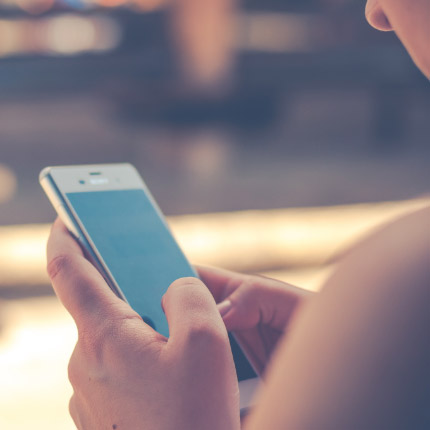Journaling is a mentally stimulating activity that can take many forms. Some people journal by writing daily passages while others prefer to write less frequently but with greater length. Still others don’t write at all but utilize a regular journal to doodle or channel their creativity in other ways. In fact, the best thing about journaling is that there aren’t boundaries. It is a boundless opportunity to express yourself.
While creative journaling techniques can be used for several reasons and certainly aren’t exclusively a mental health or relapse prevention exercise, they can be an exceptional recovery tool. Journaling and channeling creativity in the manner you most enjoy can be a marvelous mental exercise, promoting sound health and an improved quality of life.
What Is Creative Journal Writing?
Writing is the mode of creative expression most associated with journaling, so it’s fitting that the most open form of written journaling is known as “creative journaling.” Creative journals are different from a journal used exclusively for one purpose, like charting your thoughts or committing important things to memory. While that kind of journaling can be productive, it exercises different mental reflexes than a creative journal. Creative journaling allows you to add visuals to your writing, including doodles, drawings, paintings, photos, or even just pops of color.
When you’re considering the role creative journaling can play in supporting mental health, a good mindset to have is that every person is creative. Some people don’t enjoy writing while others don’t like drawing or creating visual art, but everyone can find some value in a creative journal. That’s because everyone has at least some creative passion in them somewhere. Finding it and using a creative journal to nourish and express it, can have a significant impact on your recovery.
Art Journaling Materials
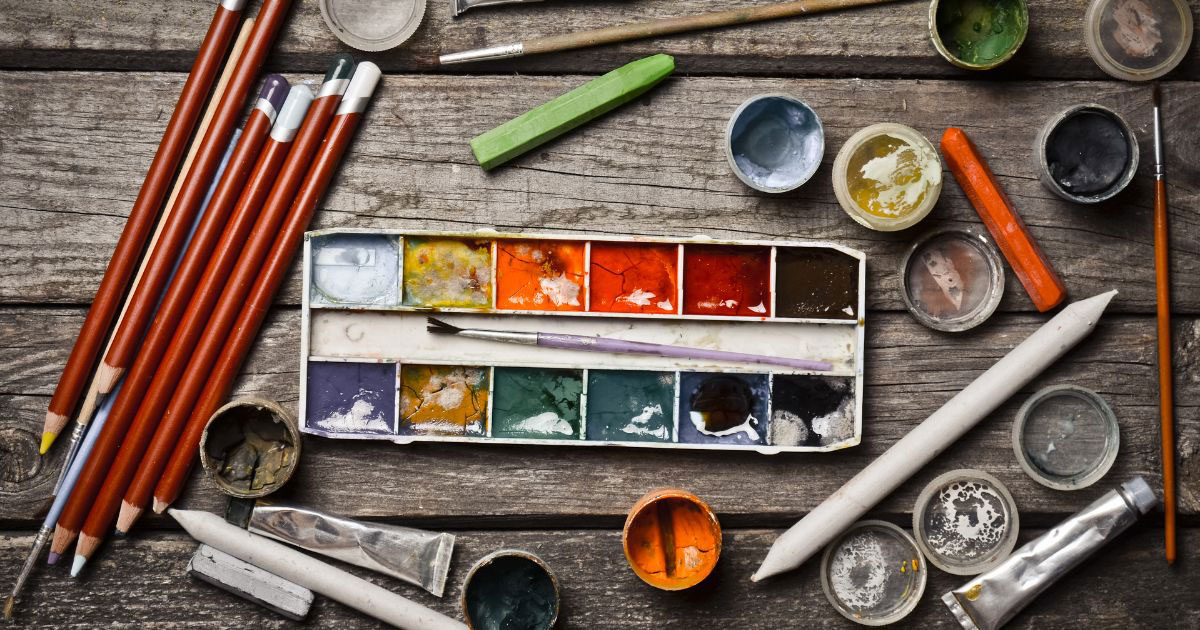
Although you can use all sorts of art material to create, all you really need is your journal and something to draw or paint with. Don’t have paint? You can get creative and use tea, coffee or even vegetables to create a stain.
Other materials you might want to experiment with:
- Watercolors
- Markers
- Pens
- Charcoal
- Pencil
- Different sizes of paint brushes
- Stickers
- Glue
- Tape
- Stencils
- Scissors
- Rulers
Scrapbooking and Collages
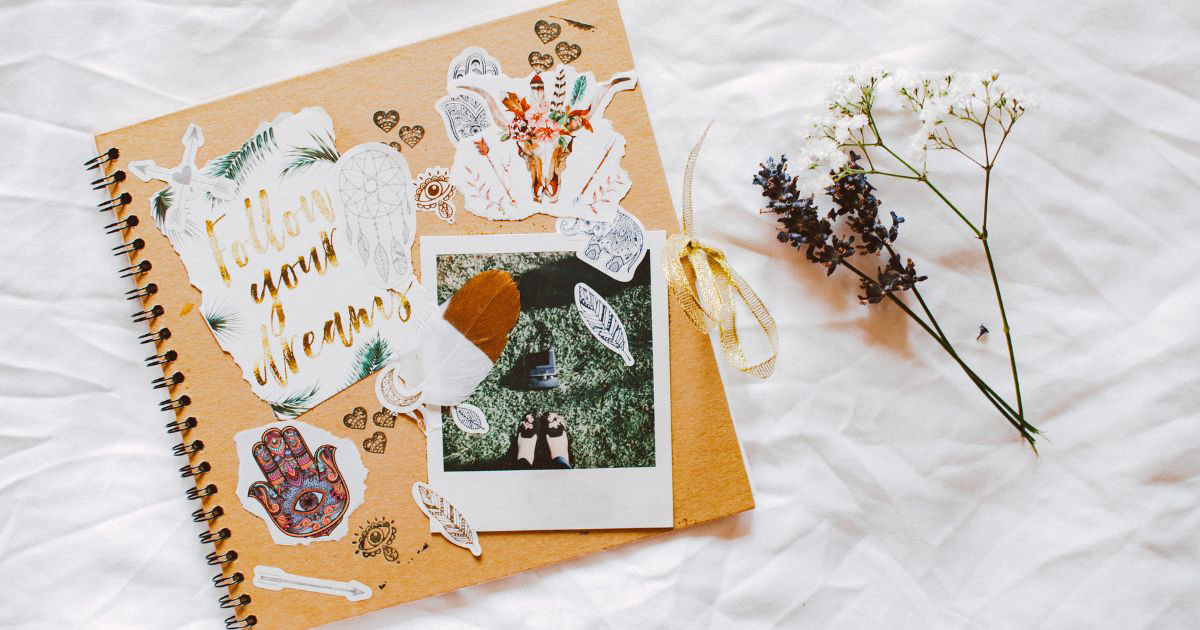
Your creative eye may be at its best looking at magazines, newspapers, or other publications and finding ways to arrange the headlines and pictures. This could take the form of scrapbooking certain types of visual content or creating collages to mix images together.
Photography
Photography is a form of art and can effectively be translated into an art journal. Find unique ways to capture your interests in film or digital photography. Construct a journal showcasing work you feel particularly passionate about and describe why you feel strongly about the images.
How to Start Your Journal to Support Mental Health
Beginners can start journaling to help refine skills used in everyday life. Whether you have experience with visual mediums, journaling, or neither of the two, creative journaling can be a creative stimulant. If something in your life naturally leads to an idea to sketch or express yourself in written form within the pages of your journal, don’t resist that urge.
Getting started writing your creative journal usually begins one of two ways: by free writing or by using a creative journaling prompt. Most people fluctuate between the two as the need strikes.
Free Writing
Free writing should be simple—just start with a blank page and write or draw anything and everything you think of. The ideas don’t have to connect or make sense together. Eventually, you will encounter an idea you want to expand on. Let your mind lead the way and add art or writing as you see fit.
If you’re having trouble beginning with a free write, try a brainstorming activity. Find your favorite method for brainstorming or try a variety.
Some recommended methods include:
- Develop a word cloud centered around the first topic you can think of, writing any words that come to mind
- Look at a visual and write about it while adding creative flair
- Add parameters to refine your thoughts on a selected idea
- Remove parameters as you hit dead ends—brainstorming is a time to go wild
Creativity Journal Prompts
Free writing isn’t for everyone. Prompt yourself with a question you find in a counseling session, peer group, or other source, or browse a list of prompts for one that strikes your fancy. Some of the best questions to explore are ones of self-discovery. Ask yourself questions about your fears, what you enjoy, or something you aspire to achieve.
Consider these prompts that relate to your recovery:
- Write about the progress you’ve made
- Write about what your recovery journey has taught you about yourself
- Write a letter to who you were in the past, now, or in the future
- Write a letter to your substance of choice
- Write about a skill or hobby you’d like to learn
- Write about your happiest moment, or your saddest moment
- Write about your goals
- Write about mistakes and lessons learned
- Write about your loved ones, and why they matter to you
- Write about your biggest recovery-related fear
- Write about what you are looking forward to the most in your recovery
Art Journaling Theme Ideas
Whether you’ve chosen a prompt or a free write, now you’ll need to add creative art to your journal. Keep in mind that a creative journal need not feature written words at all. It can involve some writing, ranging from bulleted notes to paragraphs of prose or lyrics, but creative or art journaling should also encompass visual expressions. Drawing, painting, cutting, and pasting—it’s all on the table when it comes to art journaling.
Art journaling, just like written journaling as a creative outlet, is an opportunity to experiment. Try new colors, mix colors, take an object you see every day and depict how it would look in a new color or even in grayscale. Silence that inner critic and make mistakes.
If art journaling is a new concept for you, here are some examples of themes and potential projects you could perform in the journal to get started.
Landscape Journal
Go outside. Look at the world around you. Whether you are in a rural setting, an urban cityscape, or a suburban neighborhood, artistically document what you see. If you’re tired of what you see around you, think of somewhere else you’ve been or imagine a new location altogether. How does it feel to be there? What does it sound like? Are there animals, plants or flowers growing? Take a moment to be mindful, then, bring it to life in your journal pages.
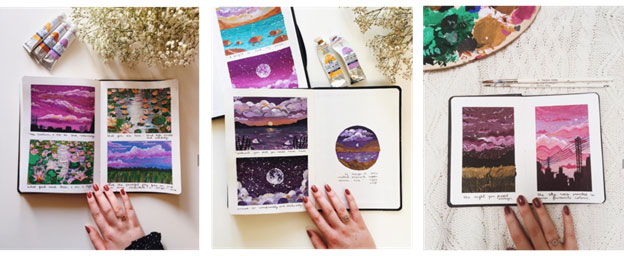
Dreamy landscapes by artist Merel Djamila
Although you don’t have to use words, a landscape can be the perfect backdrop for a beautiful quote inspired by the scene or your journal entry for the day.
Music Journal
If you’re like me you listen to music all day! Sometimes a song lyric is just so poetic it deserves its own quote art on a page. Think about a favorite artist, song or album. What about this music inspires you? Draw what you feel or find stickers or stencils that use musical instruments to represent the song. You could use sheet music for layering.
Here are some page ideas:
- Quote a lyric
- Write down how a specific song makes you feel
- Create a playlist
- Illustrate a song with a visual story
- Create your version of an album cover
- Journal about how a band or song helped get you through a hard time
- Dedicate a page to your favorite artist

Music inspired art journal page by Karen Gaunt
Dream Journal
If you remember your dreams, a creative journal is the perfect place to write and draw what happened and how you felt. Your mind may connect dots it wouldn’t otherwise in helping you understand what motivated a particular dream. You’ll also be able to connect a visual medium, your dream, to a written one in your journal.
“Dreaming is the art of the mind. Every dream is intrinsically a creative experience. As the artists of the night, we are co-participants in weaving new creations from the complexity of our entire being.” — Fariba Bogzaran and Daniel Deslauriers, Integral Dreaming: A Holistic Approach to Dreams (2012)

Dream Journal 2, 2002-2003 by artist Connie Mississippi
Starting a dream journal is simple. All it takes is an open mind, a little creativity and the willingness to experiment. It can sometimes feel incomplete to try to translate a dream into linear form, like writing. Instead, sketch out dream images in your journal upon waking. If you’re inspired to interact with the imagery further, try painting it.
Can’t really remember your dreams? That’s okay, you can still daydream!
A Gratitude Journal
When grappling with your mental health, some people find they can present their feelings better in artwork than with words. Use art to depict how you are feeling. Paired with other treatments, this could prove to be an important part of therapeutic recovery to stay on top of your mental health.
For me, simply using lines, circles and repetitive patterns has been endlessly helpful. However, in order to get the most out of the activity it’s important to start with an intention.
With mindfulness in mind, here are some gratitude prompts you might consider when working to improve your mental health:
- Make a list of five things you’re grateful for that are found in nature.
- Write about something positive that happened in your life recently that made you feel fortunate.
- I admire these three qualities in myself: list at least 3.
- What is that special person in your life? And why are you grateful for them?
- Think of the things you’re grateful to have at home and write them down.
- Write about a trip that you’ve taken with someone else that is especially memorable.
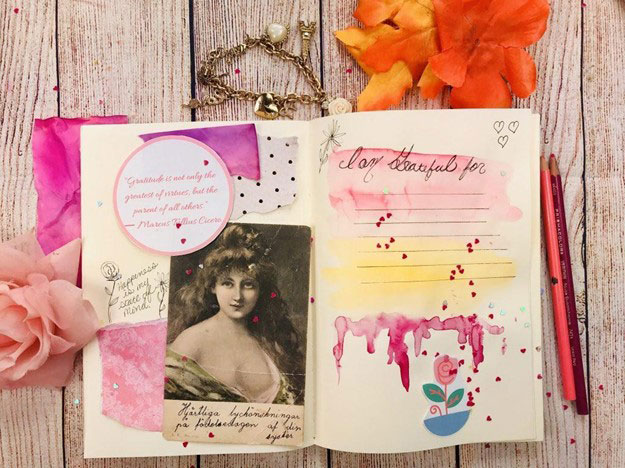
Art Journal Page by Pink Spark Studio
Travel Journal
A travel art journal is a great way to create memories, while also communicating your feelings. Making art can be tough to fit into your daily schedule, so when you travel, leave yourself some time to be alone with your work.
Here are a few ideas of types of travel journal entries you can try while traveling:
- Listicles: A photo or doodle paired with a brief description is a good way to document your travels without spending too much time writing.
- Sketch Notes: Sketch notes are the perfect way to illustrate your memories and review what you learned on your trip. These drawings will help you remember details, key points, and specifics.
- Studying the Masters: When traveling somewhere with famous artworks, try dedicating pages to replicating the greats. This is a great opportunity to learn from the best while also documenting your trip.
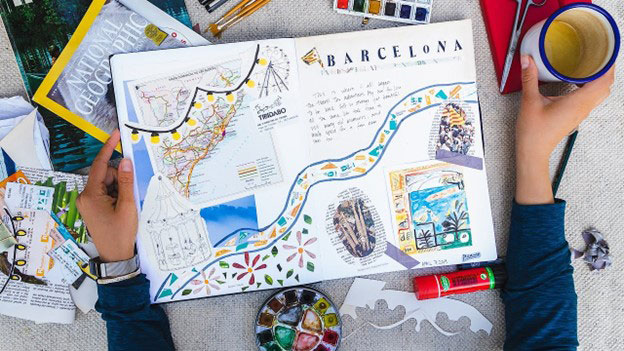
Travel Journal page from Wild We Roam
You can also create travel journal entries after your trip. Some might want to print photos to include or review sketch notes before creating other pages.
Other items you might include:
- Ticket stubs
- Programs, flyers and other printed reminders of events
- Maps and guidebooks make sure envelopes, backgrounds and pockets
- Postcards and stamps
- Stickers and other cutouts that remind you or your trip
Here are some travel journal prompts:
- I traveled to
- I love this place because
- I went here with
- The people were
- The food was
- The culture is
- The art feels
- The architecture is
- The weather was
- The nature is
- The place I stayed was
- The thing I liked the best
The Best Art Journaling Tip? Just Get Started
As mentioned, the most difficult part of creative journaling is getting started. The idea of adding journaling into your schedule can seem daunting, or maybe you remain skeptical that you are creative enough to stick with a creativity journal. Make a conscious decision to start journaling and let the experience guide you to what style of writing and art are best for you. The exercise of journaling regularly in a creative fashion is beneficial on its own, and once you find what works for you the results could be even more significant.
ECHO Recovery is committed to supporting art and creativity as avenues to improve recovery results. If you need inspiration or want to share your own creativity, share it with us by tagging ECHO Recovery on Instagram.
Happy journaling!
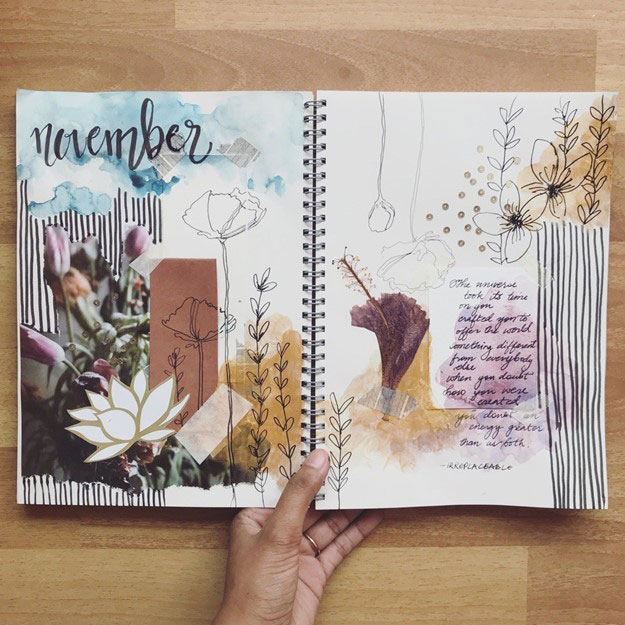
Art Journal on Behance
Jenny Weatherall is the co-owner and CEO of Eminent SEO, a design and marketing agency founded in 2009. She has worked in the industry since 2005, when she fell in love with digital marketing… and her now husband and partner, Chris. Together they have 6 children and 3 granddaughters.
Jenny has a passion for learning and sharing what she learns. She has researched, written and published hundreds of articles on a wide variety of topics, including: SEO, design, marketing, ethics, business management, sustainability, inclusion, behavioral health, wellness and work-life balance.

